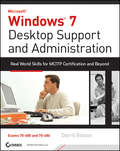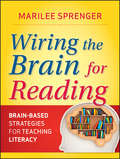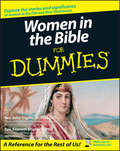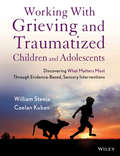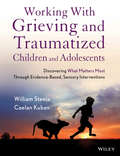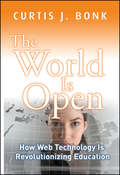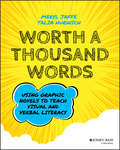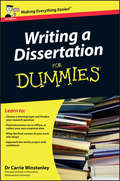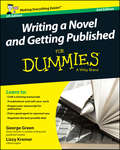- Table View
- List View
Wiley Tax Preparer: A Guide to Form 1040
by The Tax Institute at H&R BlockWhether you’re already a tax preparer or you’re looking to become one, you need a firm grasp of the tax concepts on which individual taxation is based. We created the Wiley Tax Preparer as a refresher for the experienced tax preparer, and as a readable guide for the less-experienced tax preparer. This timely guide is an essential tax resource providing you with useful information on tax principles and filing requirements that a preparer must know to complete a 1040 series return and associated schedules. You’ll refer to it time and again, for information about: Practices and Procedures Penalties to be assessed by the IRS against a preparer for disregard of the rules and regulations Furnishing a copy of a return to a taxpayer Safeguarding taxpayer information Treatment of Income and Assets Taxability of wages, salaries, tips, and other earnings Reporting requirements of Social Security benefits Determination of basis of assets Deductions and Credits Medical and dental expenses Types of interest and tax payments Child and dependent care credit Other Taxes Alternative Minimum Tax Self-Employment Tax Preliminary Work and Collection of Taxpayer Data Collecting a taxpayer’s filing information and determining their status Determine filing requirements, including extensions and amended returns Personal exemptions and dependents Completion of the Filing Process Check return for completeness and accuracy Tax withholding, payment and refund options, and estimated tax payments Explaining and reviewing the tax return Ethics and Circular 230 Preparer’s due diligence for accuracy of representations made to clients and the IRS Sanctions that may be imposed under Circular 230 Rules governing authority to practice before the IRS If you’re looking for a practical guide to the principles behind Form 1040, look no further. The Wiley Tax Preparer is the most accessible guide to understanding how complex tax laws affect individual taxpayers.
Windows 7 Desktop Support and Administration: Real World Skills for MCITP Certification and Beyond (Exams 70-685 and 70-686)
by Darril GibsonA manual for Windows 7 desktop technicians and administrators It is estimated that 90 percent of the world’s computers run Windows. Desktop technicians and administrators need this comprehensive manual to guide them through their daily work with Windows 7. While this Sybex guide is packed with information you’ll need to know for the MCITP certification exam, it is equally valuable in real-world situations you will encounter on the job. Covers troubleshooting, hardware and software applications, large-scale desktop environment management, and planning and configuring the desktop infrastructure using Windows 7 Provides plenty of relevant information for those seeking MCITP certification, including full coverage of the exam objectives for both Desktop Support Technician and Desktop Administrator exams Includes a CD with valuable study tools for the MCITP exams including video walkthroughs, flashcards, and two practice exams. Windows 7 Desktop Support and Administration provides knowledge that will be needed on certification exams and remains a valuable reference for support and administrative personnel on the job. Note: CD-ROM/DVD and other supplementary materials are not included as part of eBook file.
Windows 7 Desktop Support and Administration: Real World Skills for MCITP Certification and Beyond (Exams 70-685 and 70-686)
by Darril GibsonA manual for Windows 7 desktop technicians and administrators It is estimated that 90 percent of the world’s computers run Windows. Desktop technicians and administrators need this comprehensive manual to guide them through their daily work with Windows 7. While this Sybex guide is packed with information you’ll need to know for the MCITP certification exam, it is equally valuable in real-world situations you will encounter on the job. Covers troubleshooting, hardware and software applications, large-scale desktop environment management, and planning and configuring the desktop infrastructure using Windows 7 Provides plenty of relevant information for those seeking MCITP certification, including full coverage of the exam objectives for both Desktop Support Technician and Desktop Administrator exams Includes a CD with valuable study tools for the MCITP exams including video walkthroughs, flashcards, and two practice exams. Windows 7 Desktop Support and Administration provides knowledge that will be needed on certification exams and remains a valuable reference for support and administrative personnel on the job. Note: CD-ROM/DVD and other supplementary materials are not included as part of eBook file.
Wiring the Brain for Reading: Brain-Based Strategies for Teaching Literacy
by Marilee B. SprengerUsing the latest neuroscience research to enhance literacy instruction Wiring the Brain for Reading introduces teachers to aspects of the brain's functions that are essential to language and reading development. Marilee Sprenger, a specialist in learning and the brain, provides practical, brain friendly, strategies for teaching essential skills like phonemic awareness, phonics, fluency, vocabulary, and comprehension. The author's innovative approach aligns well with the Common Core State Standards for English Language Arts and is designed to enhance students' motivation and excitement in reading. Offers a clear explanation of brain functioning in order to enhance language and reading instruction Incorporates proven literacy strategies, games, and activities as well as classroom examples Aligns with Common Core State Standards for learning to read, developing fluency, and interpreting complex texts Wiring the Brain for Reading offers practical strategies for applying the latest research in neuroscience and learning to the classroom.
Wiring the Brain for Reading: Brain-Based Strategies for Teaching Literacy
by Marilee B. SprengerUsing the latest neuroscience research to enhance literacy instruction Wiring the Brain for Reading introduces teachers to aspects of the brain's functions that are essential to language and reading development. Marilee Sprenger, a specialist in learning and the brain, provides practical, brain friendly, strategies for teaching essential skills like phonemic awareness, phonics, fluency, vocabulary, and comprehension. The author's innovative approach aligns well with the Common Core State Standards for English Language Arts and is designed to enhance students' motivation and excitement in reading. Offers a clear explanation of brain functioning in order to enhance language and reading instruction Incorporates proven literacy strategies, games, and activities as well as classroom examples Aligns with Common Core State Standards for learning to read, developing fluency, and interpreting complex texts Wiring the Brain for Reading offers practical strategies for applying the latest research in neuroscience and learning to the classroom.
Wise Decisions: A Science-Based Approach to Making Better Choices
by James E. Loehr Sheila Ohlsson WalkerA concrete and hands-on method for improving your everyday decisions Every 15 minutes, each of us can make ten or more small decisions. Some of them are relatively inconsequential, while others can change the course of our lives. What if you could improve all of your decisions, across the board, and start to build a healthier, more productive, and meaningful life? In Wise Decisions: A Science-Based Approach to Making Better Choices, a team of accomplished industry experts delivers an evidence- and research-based blueprint for making the best decisions you can with the information you have. You’ll learn to make the targeted, repeated investment of energy required to turn your decision-making process into one informed by reason, emotion, intuition, and science. In the book, you’ll discover: How to put the decision-making process under a microscope and learn what makes a decision truly wise Ways to help children, teens, and families make wise decisions How to train yourself to make wise decisions with voice training and other strategiesA can’t-miss resource for parents, teachers, coaches, managers, executives, and other business leaders, Wise Decisions also offers timeless advice and guidance for anyone else hoping to improve the decision-making abilities of the people close to them.
Wise Decisions: A Science-Based Approach to Making Better Choices
by James E. Loehr Sheila Ohlsson WalkerA concrete and hands-on method for improving your everyday decisions Every 15 minutes, each of us can make ten or more small decisions. Some of them are relatively inconsequential, while others can change the course of our lives. What if you could improve all of your decisions, across the board, and start to build a healthier, more productive, and meaningful life? In Wise Decisions: A Science-Based Approach to Making Better Choices, a team of accomplished industry experts delivers an evidence- and research-based blueprint for making the best decisions you can with the information you have. You’ll learn to make the targeted, repeated investment of energy required to turn your decision-making process into one informed by reason, emotion, intuition, and science. In the book, you’ll discover: How to put the decision-making process under a microscope and learn what makes a decision truly wise Ways to help children, teens, and families make wise decisions How to train yourself to make wise decisions with voice training and other strategiesA can’t-miss resource for parents, teachers, coaches, managers, executives, and other business leaders, Wise Decisions also offers timeless advice and guidance for anyone else hoping to improve the decision-making abilities of the people close to them.
Women and Educational Leadership (Jossey-Bass Leadership Library in Education #10)
by Margaret Grogan Charol ShakeshaftThis groundbreaking book presents a new way of looking at leadership that is anchored in research on women leaders in education. The authors examine how successful women in education lead and offer suggestions and ideas for developing and honing these exemplary leadership practices. Women and Educational Leadership shows how the qualities that characterize women's approaches to leadership differ from traditional approaches?whether the traditional leader is a woman or a man. The authors reveal that women leaders are more collaborative by nature and demonstrate a commitment to social justice. They tend to bring an instructional focus to leadership, include spiritual dimensions in their work, and strive for balance between the personal and professional. This important book offers a new model of leadership that shifts away from the traditional heroic notion of leadership to the collective account of leadership that focuses on leadership for a specific purpose—like social justice. The authors include illustrative examples of leaders who have brought diverse groups to work toward common ground. They also show how leadership is a way to facilitate and support the work of organizational members. The ideas and suggestions presented throughout the book can help the next generation fulfill the promise of a new tradition of leadership. Women and Educational Leadership is part of the Jossey-Bass Leadership Library in Education series.
Women and Educational Leadership (Jossey-Bass Leadership Library in Education #10)
by Margaret Grogan Charol ShakeshaftThis groundbreaking book presents a new way of looking at leadership that is anchored in research on women leaders in education. The authors examine how successful women in education lead and offer suggestions and ideas for developing and honing these exemplary leadership practices. Women and Educational Leadership shows how the qualities that characterize women's approaches to leadership differ from traditional approaches?whether the traditional leader is a woman or a man. The authors reveal that women leaders are more collaborative by nature and demonstrate a commitment to social justice. They tend to bring an instructional focus to leadership, include spiritual dimensions in their work, and strive for balance between the personal and professional. This important book offers a new model of leadership that shifts away from the traditional heroic notion of leadership to the collective account of leadership that focuses on leadership for a specific purpose—like social justice. The authors include illustrative examples of leaders who have brought diverse groups to work toward common ground. They also show how leadership is a way to facilitate and support the work of organizational members. The ideas and suggestions presented throughout the book can help the next generation fulfill the promise of a new tradition of leadership. Women and Educational Leadership is part of the Jossey-Bass Leadership Library in Education series.
Women in the Bible For Dummies
by Rev. John Trigilio Jr. Rev. Kenneth BrighentiComprehensive interfaith coverage of the important female figures This friendly, approachable guide introduces readers to the famous and infamous women of Scripture, describing in everyday language the contributions these women made in their time and ours. From Eve, Sarah, and Esther to Mary and Mary Magdalene, it discusses well-known women of both the Old and New Testaments, examining their role in Biblical narratives, their place in the Jewish and Christian faiths, and the lessons their stories impart to women today.
Women in the Higher Education C-Suite: Diverse Executive Profiles
by Lisa Mednick TakamiExplore how women have succeeded in higher education administration through the collective wisdom of diverse college and university leaders As the percentage of women college and university presidents continues to increase, more and more women are considering academic administration as a viable career. Current and future leaders who aspire to rise to the top ranks of a college or university need a path to help them navigate the various issues they might encounter in today’s academic institutions. Women in the Higher Education C-Suite: Diverse Executive Profiles explores the personal narratives of a diverse group of women CEOs and senior executives serving in two- and four-year public and private colleges and universities in the United States. Emphasizing real-world leadership, this book focuses on the remarkable women who continue to break barriers and inspire the next generation of leaders. Author Lisa Mednick Takami, Ed.D. draws from extended qualitative interviews with successful higher education CEOs and senior leaders to highlight their lived experiences, career trajectories, leadership lessons, and much more. Throughout the book, the leaders discuss common obstacles and offer recommendations to help you overcome them in your professional journey. Those profiled include: Dr. Mildred García, President, American Association of State Colleges & Universities Dr. Linda Oubré, President, Whittier College Dr. Dena P. Maloney, Retired Superintendent/President, El Camino Community College District Dr. Katrice Albert, Vice President Office of Institutional Diversity, University of Kentucky Dr. Jane Conoley, President, California State University, Long Beach Dr. Sandra Boham, President, Salish Kootenai Community College Dr. Judy P. Sakaki, President Emeritus, Sonoma State University Dr. Becky Petitt, Vice Chancellor for Equity, Diversity, and Inclusion, University of California, San Diego Dr. Erika Endrijonas, Superintendent/President, Pasadena Community College District Dr. Javaune Adams-Gaston, Norfolk State University Dr. Joanne Li, Chancellor, University of Nebraska, Omaha Focuses on the real experiences and formative development of current women leaders Discusses topics such as work-life balance, career change, and professional legacy Addresses how women leaders navigated the COVID-19 pandemic and the Black Lives Matter and Me Too movementsWomen in the Higher Education C-Suite: Designed to provide inspiration and guidance for future women leaders, Women in the Higher Education C-Suite: Diverse Executive Profiles is a must-read for educators, researchers, administrators, pre-service teachers, students in leadership courses, and women executives from other fields interested in pursuing senior-level college and university administration positions.
Women in the Higher Education C-Suite: Diverse Executive Profiles
by Lisa Mednick TakamiExplore how women have succeeded in higher education administration through the collective wisdom of diverse college and university leaders As the percentage of women college and university presidents continues to increase, more and more women are considering academic administration as a viable career. Current and future leaders who aspire to rise to the top ranks of a college or university need a path to help them navigate the various issues they might encounter in today’s academic institutions. Women in the Higher Education C-Suite: Diverse Executive Profiles explores the personal narratives of a diverse group of women CEOs and senior executives serving in two- and four-year public and private colleges and universities in the United States. Emphasizing real-world leadership, this book focuses on the remarkable women who continue to break barriers and inspire the next generation of leaders. Author Lisa Mednick Takami, Ed.D. draws from extended qualitative interviews with successful higher education CEOs and senior leaders to highlight their lived experiences, career trajectories, leadership lessons, and much more. Throughout the book, the leaders discuss common obstacles and offer recommendations to help you overcome them in your professional journey. Those profiled include: Dr. Mildred García, President, American Association of State Colleges & Universities Dr. Linda Oubré, President, Whittier College Dr. Dena P. Maloney, Retired Superintendent/President, El Camino Community College District Dr. Katrice Albert, Vice President Office of Institutional Diversity, University of Kentucky Dr. Jane Conoley, President, California State University, Long Beach Dr. Sandra Boham, President, Salish Kootenai Community College Dr. Judy P. Sakaki, President Emeritus, Sonoma State University Dr. Becky Petitt, Vice Chancellor for Equity, Diversity, and Inclusion, University of California, San Diego Dr. Erika Endrijonas, Superintendent/President, Pasadena Community College District Dr. Javaune Adams-Gaston, Norfolk State University Dr. Joanne Li, Chancellor, University of Nebraska, Omaha Focuses on the real experiences and formative development of current women leaders Discusses topics such as work-life balance, career change, and professional legacy Addresses how women leaders navigated the COVID-19 pandemic and the Black Lives Matter and Me Too movements Designed to provide inspiration and guidance for future women leaders, Women in the Higher Education C-Suite: Diverse Executive Profiles is a must-read for educators, researchers, administrators, pre-service teachers, students in leadership courses, and women executives from other fields interested in pursuing senior-level college and university administration positions.
Working with Grieving and Traumatized Children and Adolescents: Discovering What Matters Most Through Evidence-Based, Sensory Interventions
by William Steele Caelan KubanPraise for Working With Grieving and Traumatized Children and Adolescents "This much-needed book effectively argues for the use of structured activities as the basis for exploring trauma-specific questions in clinical work with traumatized children and adolescents. Numerous examples of children's artwork enhance the book and illustrate the effectiveness of the treatment. The authors' methods have been used successfully for many years and represent a major contribution to the study of trauma that will be welcomed by both students and seasoned practitioners." —Nancy Boyd Webb, DSW, LICSW, RPT-S Professor of Social Work Emerita, Fordham University, Author: Play Therapy With Children in Crisis "The authors provide a clear theoretical framework and demonstrate practical sensory-based activities so kids can discover and reconnect with their bodies' agency and vitality. Refreshingly, this vehicle creates an emotionally safe journey for the child into the mystery of the experiential, embedded in implicit memory. It's chock-full of invitations to explore self-impressions and worldviews in a way that children feel seen, not assessed." —Peter A. Levine, PhD, and Maggie Kline, MS, LMFT, Coauthors: Trauma Through a Child's Eyes and Trauma-Proofing Your Kids A structured, sequential, and evidence-based approach for the treatment of children and adolescents experiencing trauma or grief Working With Grieving and Traumatized Children and Adolescents features the Structured Sensory Interventions for Traumatized Children, Adolescents and Parents (SITCAP) intervention model, proven in successfully addressing violent situations such as murder, domestic violence, and physical abuse, as well as non-violent grief- and trauma-inducing situations including divorce, critical injuries, car fatalities, terminal illness, and environmental disasters. Filled with practical and proven activities for use with children and adolescents experiencing trauma and grief, this resource is based on the authors' experience working with all types of traumatic events in school-, agency-, and community-based programs across the country.
Working with Grieving and Traumatized Children and Adolescents: Discovering What Matters Most Through Evidence-Based, Sensory Interventions
by William Steele Caelan KubanPraise for Working With Grieving and Traumatized Children and Adolescents "This much-needed book effectively argues for the use of structured activities as the basis for exploring trauma-specific questions in clinical work with traumatized children and adolescents. Numerous examples of children's artwork enhance the book and illustrate the effectiveness of the treatment. The authors' methods have been used successfully for many years and represent a major contribution to the study of trauma that will be welcomed by both students and seasoned practitioners." —Nancy Boyd Webb, DSW, LICSW, RPT-S Professor of Social Work Emerita, Fordham University, Author: Play Therapy With Children in Crisis "The authors provide a clear theoretical framework and demonstrate practical sensory-based activities so kids can discover and reconnect with their bodies' agency and vitality. Refreshingly, this vehicle creates an emotionally safe journey for the child into the mystery of the experiential, embedded in implicit memory. It's chock-full of invitations to explore self-impressions and worldviews in a way that children feel seen, not assessed." —Peter A. Levine, PhD, and Maggie Kline, MS, LMFT, Coauthors: Trauma Through a Child's Eyes and Trauma-Proofing Your Kids A structured, sequential, and evidence-based approach for the treatment of children and adolescents experiencing trauma or grief Working With Grieving and Traumatized Children and Adolescents features the Structured Sensory Interventions for Traumatized Children, Adolescents and Parents (SITCAP) intervention model, proven in successfully addressing violent situations such as murder, domestic violence, and physical abuse, as well as non-violent grief- and trauma-inducing situations including divorce, critical injuries, car fatalities, terminal illness, and environmental disasters. Filled with practical and proven activities for use with children and adolescents experiencing trauma and grief, this resource is based on the authors' experience working with all types of traumatic events in school-, agency-, and community-based programs across the country.
Working with Problem Faculty: A Six-Step Guide for Department Chairs
by R. Kent CrookstonWorking with Problem Faculty When asked to name their number one concern and problem, department leaders overwhelmingly said that it was dealing with difficult people. Now R. Kent Crookston draws on the wisdom of seasoned department chairs, the academic literature, and his own experience as a department head and dean to shed new light on this perennial problem. Working with Problem Faculty outlines a practical six-step process that aims at improving an entire department and charts a clear course for dealing with problem faculty by Clarifying values and expectations Following policy Building trust with colleagues Evaluating yourself and your perceptions Listening Taking appropriate action By following these six steps, department chairs are able to challenge problem faculty with consideration, confidence, and effectiveness. "Anyone seeking practical help in dealing with difficult people will appreciate this book. Using relevant examples, Crookston describes a six-step process for managing people who might appear to be unmanageable." —Mary Lou Higgerson, vice president for academic affairs emeritus, Baldwin Wallace University "Crookston has done his homework. After careful research and decades of personal experience Dr. Crookston shares a practical, insightful, and crucial handbook for addressing the most formidable challenge all leaders face. And best of all, he doesn't just advise on how to act when things go wrong, he gives proactive guidance to ensure that things go right." —Joseph Grenny, New York Times bestselling coauthor of Change Anything and Crucial Conversations: Tools for Talking When Stakes are High
Working with Problem Faculty: A Six-Step Guide for Department Chairs
by R. Kent CrookstonWorking with Problem Faculty When asked to name their number one concern and problem, department leaders overwhelmingly said that it was dealing with difficult people. Now R. Kent Crookston draws on the wisdom of seasoned department chairs, the academic literature, and his own experience as a department head and dean to shed new light on this perennial problem. Working with Problem Faculty outlines a practical six-step process that aims at improving an entire department and charts a clear course for dealing with problem faculty by Clarifying values and expectations Following policy Building trust with colleagues Evaluating yourself and your perceptions Listening Taking appropriate action By following these six steps, department chairs are able to challenge problem faculty with consideration, confidence, and effectiveness. "Anyone seeking practical help in dealing with difficult people will appreciate this book. Using relevant examples, Crookston describes a six-step process for managing people who might appear to be unmanageable." —Mary Lou Higgerson, vice president for academic affairs emeritus, Baldwin Wallace University "Crookston has done his homework. After careful research and decades of personal experience Dr. Crookston shares a practical, insightful, and crucial handbook for addressing the most formidable challenge all leaders face. And best of all, he doesn't just advise on how to act when things go wrong, he gives proactive guidance to ensure that things go right." —Joseph Grenny, New York Times bestselling coauthor of Change Anything and Crucial Conversations: Tools for Talking When Stakes are High
The World Is Open: How Web Technology Is Revolutionizing Education (Wiley Desktop Editions Ser.)
by Curtis J. BonkDiscover the dramatic changes that are affecting all learners Web-based technology has opened up education around the world to the point where anyone can learn anything from anyone else at any time. To help educators and others understand what's possible, Curt Bonk employs his groundbreaking "WE-ALL-LEARN" model to outline ten key technology and learning trends, demonstrating how technology has transformed educational opportunities for learners of every age in every corner of the globe. The book is filled with inspiring stories of ordinary learners as well as interviews with technology and education leaders that reveal the power of this new way of learning. Captures the global nature of open education from those who are creating and using new learning technologies Includes a new Preface and Postscript with the latest updates A free companion web site provides additional stories and information Using the dynamic "WE-ALL-LEARN" model, learners, educators, executives, administrators, instructors, and parents can discover how to tap into the power of Web technology and unleash a world of information.
The World Is Open: How Web Technology Is Revolutionizing Education
by Curtis J. BonkDiscover the dramatic changes that are affecting all learners Web-based technology has opened up education around the world to the point where anyone can learn anything from anyone else at any time. To help educators and others understand what's possible, Curt Bonk employs his groundbreaking "WE-ALL-LEARN" model to outline ten key technology and learning trends, demonstrating how technology has transformed educational opportunities for learners of every age in every corner of the globe. The book is filled with inspiring stories of ordinary learners as well as interviews with technology and education leaders that reveal the power of this new way of learning. Captures the global nature of open education from those who are creating and using new learning technologies Includes a new Preface and Postscript with the latest updates A free companion web site provides additional stories and information Using the dynamic "WE-ALL-LEARN" model, learners, educators, executives, administrators, instructors, and parents can discover how to tap into the power of Web technology and unleash a world of information.
Worth A Thousand Words: Using Graphic Novels to Teach Visual and Verbal Literacy
by Meryl Jaffe Talia HurwichUse graphic novels to teach visual and verbal literacy While our kids today are communicating outside the classroom in abbreviated text bursts with visual icons, teachers are required to teach them to critically listen, think, and read and write complex texts. Graphic novels are a uniquely poised vehicle we can use to bridge this dissonance between student communication skills and preferences with mandated educational goals. Worth a Thousand Words details how and why graphic novels are complex texts with advanced-level vocabulary, and demonstrates how to read and analyze these texts. It includes practical advice on how to integrate these books into both ELA and content-area classrooms and provides an extensive list of appropriate graphic novels for K-8 students, lesson suggestions, paired graphic/prose reading suggestions, and additional resources for taking these texts further. Provides research to back up why graphic novels are such powerful educational tools Helps you engage diverse student learners with exciting texts Shows you how to make lessons more meaningful Offers advice on implementing new literary mediums into your classroom Perfect for parents and teachers in grades K-8, Worth a Thousand Words opens up an exciting new world for teaching children visual and verbal literacy.
Worth A Thousand Words: Using Graphic Novels to Teach Visual and Verbal Literacy
by Meryl Jaffe Talia HurwichUse graphic novels to teach visual and verbal literacy While our kids today are communicating outside the classroom in abbreviated text bursts with visual icons, teachers are required to teach them to critically listen, think, and read and write complex texts. Graphic novels are a uniquely poised vehicle we can use to bridge this dissonance between student communication skills and preferences with mandated educational goals. Worth a Thousand Words details how and why graphic novels are complex texts with advanced-level vocabulary, and demonstrates how to read and analyze these texts. It includes practical advice on how to integrate these books into both ELA and content-area classrooms and provides an extensive list of appropriate graphic novels for K-8 students, lesson suggestions, paired graphic/prose reading suggestions, and additional resources for taking these texts further. Provides research to back up why graphic novels are such powerful educational tools Helps you engage diverse student learners with exciting texts Shows you how to make lessons more meaningful Offers advice on implementing new literary mediums into your classroom Perfect for parents and teachers in grades K-8, Worth a Thousand Words opens up an exciting new world for teaching children visual and verbal literacy.
Woven Together: How Unpacking Your Teacher Identity Creates a Stronger Learning Community
by Courtney E. RoseCreate an inspiring, humanizing, and student-driven learning experience for your classroom In Woven Together: How Unpacking Your Teacher Identity Creates a Stronger Learning Community, expert educator Dr. Courtney E. Rose delivers a student-driven approach to teaching that demonstrates how to bring your full self to the classroom. You’ll learn to create space for your students to do the same thing, de-standardizing the current norms of the classroom while embracing their unique experiences, perspectives and understandings to create more meaningful learning experiences. Focusing specifically on teachers and teacher educators, this book explains the core issues associated with curriculum design and instructional implementation. It also includes: Personal narratives from current educators and activities for deep reflection on how your identity impacts and informs your instruction Methods for co-creating a classroom community and culture that works for your diverse student body Action-oriented solutions and strategies for creating transformative learning experiences by putting your students at the forefront of your classroom’s learning environmentAn indispensable resource for teachers already in the classroom, as well as pre-service teachers preparing to enter the classroom, Woven Together is the student-focused guide that education professionals have been waiting for.
Woven Together: How Unpacking Your Teacher Identity Creates a Stronger Learning Community
by Courtney E. RoseCreate an inspiring, humanizing, and student-driven learning experience for your classroom In Woven Together: How Unpacking Your Teacher Identity Creates a Stronger Learning Community, expert educator Dr. Courtney E. Rose delivers a student-driven approach to teaching that demonstrates how to bring your full self to the classroom. You’ll learn to create space for your students to do the same thing, de-standardizing the current norms of the classroom while embracing their unique experiences, perspectives and understandings to create more meaningful learning experiences. Focusing specifically on teachers and teacher educators, this book explains the core issues associated with curriculum design and instructional implementation. It also includes: Personal narratives from current educators and activities for deep reflection on how your identity impacts and informs your instruction Methods for co-creating a classroom community and culture that works for your diverse student body Action-oriented solutions and strategies for creating transformative learning experiences by putting your students at the forefront of your classroom’s learning environmentAn indispensable resource for teachers already in the classroom, as well as pre-service teachers preparing to enter the classroom, Woven Together is the student-focused guide that education professionals have been waiting for.
Writing a Dissertation For Dummies
by Carrie WinstanleyProducing a dissertation has become a major requirement of most university courses, both undergraduate and Masters. It's likely to be the largest single piece of work you'll have to submit - and also the hardest! Writing a Dissertation For Dummies walks you through all the practical and theoretical aspects of writing a dissertation to help you produce a first-class work. This guide is ideal for any student in the broad range of the social sciences, from anthropology to law, psychology to media studies. From choosing a topic, to researching the literature, utilising your supervisor, managing your time, and structuring and writing your dissertation, you'll be able to avoid all the common mistakes and stay on top of your workload throughout the process. You'll also find tips on the best way to reference your work, and expert advice on presentation and binding. This is a must if you want to maximise your marks on your university dissertation. Writing a Dissertation For Dummies covers: Part I: What is a Dissertation? Chapter 1: So You Have to Write a Dissertation Chapter 2: Thinking About a Research Question Part II: Getting Set Up for Your Dissertation Chapter 3: The Structure of Your Dissertation Chapter 4: Getting Started Chapter 5: Finalising Your Research Question, Dissertation 'Type' And Considering Ethics Chapter 6: Reading Efficiently and Taking Useful Notes Part III: Getting On With Your Research Chapter 7: Researching in Libraries and the Using the Internet Chapter 8: Creating Your Own Empirical Data Chapter 9: Analysing Data And Drawing Conclusions Chapter 10: Staying on Track Part IV: Writing and Polishing Chapter 11: Managing Your Argument: 'Writing Up' Your Non-Empirical Dissertation Chapter 12: Writing Up Your Empirical Dissertation Chapter 13: Writing Effectively Chapter 14: References, Bibliographies and Appendices Chapter 15: Sorting Out The Presentation of Your Dissertation Part V: Managing The Overall Experience Chapter 16: Your Work Habits Chapter 17: Looking After Yourself Physically and Emotionally Chapter 18: Ten Common Dissertation Pitfalls to Avoid Chapter 19: Ten Essential Tips For Completing Your Dissertation Chapter 20: Ten Items For Your Very Final Checklist
Writing a Dissertation For Dummies
by Carrie WinstanleyProducing a dissertation has become a major requirement of most university courses, both undergraduate and Masters. It's likely to be the largest single piece of work you'll have to submit - and also the hardest! Writing a Dissertation For Dummies walks you through all the practical and theoretical aspects of writing a dissertation to help you produce a first-class work. This guide is ideal for any student in the broad range of the social sciences, from anthropology to law, psychology to media studies. From choosing a topic, to researching the literature, utilising your supervisor, managing your time, and structuring and writing your dissertation, you'll be able to avoid all the common mistakes and stay on top of your workload throughout the process. You'll also find tips on the best way to reference your work, and expert advice on presentation and binding. This is a must if you want to maximise your marks on your university dissertation. Writing a Dissertation For Dummies covers: Part I: What is a Dissertation? Chapter 1: So You Have to Write a Dissertation Chapter 2: Thinking About a Research Question Part II: Getting Set Up for Your Dissertation Chapter 3: The Structure of Your Dissertation Chapter 4: Getting Started Chapter 5: Finalising Your Research Question, Dissertation 'Type' And Considering Ethics Chapter 6: Reading Efficiently and Taking Useful Notes Part III: Getting On With Your Research Chapter 7: Researching in Libraries and the Using the Internet Chapter 8: Creating Your Own Empirical Data Chapter 9: Analysing Data And Drawing Conclusions Chapter 10: Staying on Track Part IV: Writing and Polishing Chapter 11: Managing Your Argument: 'Writing Up' Your Non-Empirical Dissertation Chapter 12: Writing Up Your Empirical Dissertation Chapter 13: Writing Effectively Chapter 14: References, Bibliographies and Appendices Chapter 15: Sorting Out The Presentation of Your Dissertation Part V: Managing The Overall Experience Chapter 16: Your Work Habits Chapter 17: Looking After Yourself Physically and Emotionally Chapter 18: Ten Common Dissertation Pitfalls to Avoid Chapter 19: Ten Essential Tips For Completing Your Dissertation Chapter 20: Ten Items For Your Very Final Checklist
Writing a Novel and Getting Published For Dummies UK
by George Green Lizzy E. KremerLearn to: Craft a winning manuscript Troubleshoot and edit your work Prepare your manuscript for publication Find a good agent to represent you Negotiate the best possible deal Turn your aspiration into reality with this completely updated guide If you’ve always wanted to write that great novel, but never knew where to start, look no further! With a published author advising you on how to write well and a literary agent providing insight into getting a publishing deal, this updated guide gives you the inside track on the art and science of breaking into the fiction-publishing industry. Taking you step by step from concept to contract, this book provides the tools you need to tell your story with skill and approach agents and publishers with confidence. Dive in — check out how to combine your natural talent with the writing techniques used by successful authors Establish a firm foundation — construct your basic story, plot and structure Examine the key elements — create characters, develop dialogue, explore relationships and insert conflict Fine-tune and finish up — discover tips on adding detail, creativity and flair while bringing your work to a close Get published — take the next step by weighing up your publishing options, working with agents and negotiating deals Find out more — check out additional advice, like the most common mistakes you need to avoid, and tips from published authors Open the book and find: Tips for getting started Creative ways to develop plots, storylines, characters and dialogue The seven basic stories and how to put them to work Tricks for crafting a great ending to your novel How to prepare your manuscript for editing and publishing The lowdown on the business side of publishing

